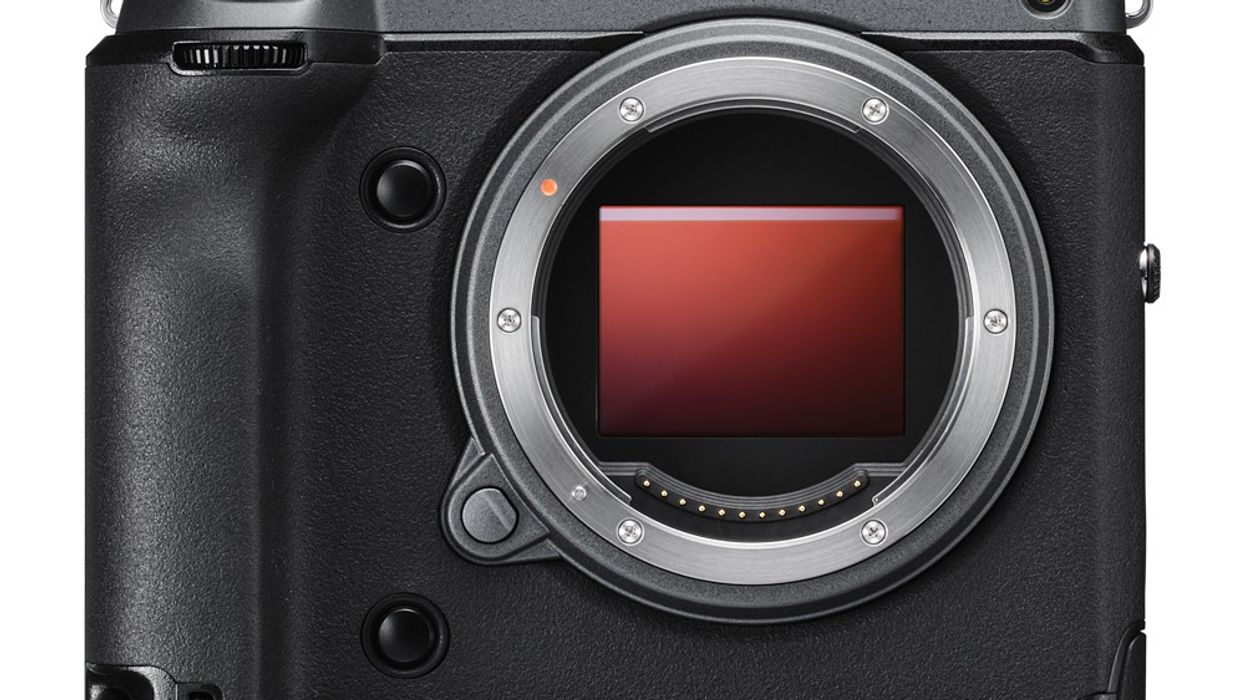4K Medium Format Video Is Here: Meet the Fujifilm GFX 100
Fujifilm skips over full-frame and goes straight to medium format with the GFX-100 coming in under $10,000 this summer.

It's not secret we are excited about the promise of medium format mirrorless cameras. Between our tests with the Hasselblad platform and our general appreciate for all things large sensor, we've known that we were getting closer and closer to having useable medium format cinematography solutions.
Why is that so exciting?
Well, as seen with the popularity of "full frame" cameras like the Alexa LF, Sony VENICE, and RED Monstro, a larger sensor really does create a different image. You get better low light performance, and you get a whole different view on the scene. Of course nothing good comes without drawbacks; you need lenses that are designed to cover the sensor, you have a smaller depth of field, and generally, things cost more.
A lot of those drawbacks are about to be overcome with the new GFX-100 from Fujifilm, shipping this summer for under $10,000.
This particular camera is exciting for filmmakers not just for being medium format and recording in 4K (full DCI 4K, in fact, not just UHD), but the entire ecosystem around it that will allow for a more painless shooting situation.
Fujifilm is well known for their amazing glass, and they've allready been rolling out G-series medium format lenses for several years that are well prepared for working with this new body. On top of that, as we saw in our tests with the X-H1, in-camera image stabilization (IBIS) has been a real priority for Fujifilm. That same IBIS tech is rolling out in the GFX, which is a huge bonus. IBIS matters less in a big heavy camera where the inertia of the camera body keeps it more stable, but with smaller cameras, IBIS is super useful for both stills and video, and having it here will make it a much more useful camera body.
On top of that, the body is rolling out with the same image processing system as the X-T3, which has been incredibly popular with video shooters (which we saw all over NAB this year). It also comes with phase detect autofocus, and while a lot of filmmakers avoid autofocus, sometimes it is the only way to get the shot when you are out alone on a gig, and the technology for that is getting better and better.
They have also gone with the more traditional Bayer sensor array here, as opposed to their special Fuij X-Trans, and while we love the color reproduction of X-Trans, we are confident that Bayer is the right choice for the processing demands of this big sensor.
The camera will allow for 10-bit 4:2:0 internal H.265 recording of full-sensor 4K DCI video up to 30fps, and will support 4:2:2 output for working with an external recorder like the Atomos Shogun. No word on support for RAW over HDMI yet, but with Nikon supporting it we know it's technically possible and we suspect we're going to see that feature roll out wider in the near future for many manufacturers.
The viewfinder is also removable, which will be a nice feature when working with the camera rigged on a stabilizer, both keeping weight down and potentially helping with clearing arms on a smaller gimbal.
The big outstanding question is going to be rolling shutter. Rolling shutter problems are typical when we first bump up to larger sensor sizes, and this is a big jump. However, for many situations (especially handheld rolling artifacts), the IBIS should help a bit. And learning to work with rolling shutters has been something many filmmakers have adapted to.
Tech Specs
- 102 million pixels effective pixels
- 43.8mm×32.9mm Bayer array with primary color filter
- SD Card (-2GB) / SDHC Card (-32GB) / SDXC Card (-512GB) UHS-I / UHS-II / Video Speed Class V90 *1
- JPEG (Exif Ver.2.3)*2, RAW : 14bit / 16bit RAW (RAF original format), RAW+JPEG, 8-bit /16-bit (10-bit output in 16bit file) TIFF (In-camera Raw Conversion Only)
- FUJIFILM G mount
- ISO100~12800 (1/3 step) (Movie: AUTO / ISO200~12800) ISO50 / 25600 / 51200 / 102400 (Movie: ISO25600)
- Focal Plane Shutter
- MOV (MPEG-4 AVC / H.264, HEVC / H.265, Audio : Linear PCM / Stereo sound 24bit / 48KHz sampling) All Intra/Long-GOP
- * All Intra can be used with following settings. DCI4K/4K 29.97p/25p/24p/23.98p 400Mbps
- Full HD(2048×1080)/Full HD(1920×1080) 59.94p/50p/29.97p/25p/24p/23.98p 200Mbps
- [DCI4K (4096×2160)] 29.97p / 25p / 24p / 23.98p 400Mbps/200Mbps/100Mbps up to Approx. 60min. [4K (3840×2160)] 29.97p / 25p / 24p / 23.98p 400Mbps/200Mbps/100Mbps up to Approx. 60min. [Full HD (2048×1080)] 29.97p / 25p / 24p / 23.98p 200Mbps/100Mbps/50Mbps up to Approx. 80min. [Full HD (1920×1080)] 29.97p / 25p / 24p / 23.98p 200Mbps/100Mbps/50Mbps up to Approx. 80min. * For recording movies, use a SD memory card with UHS Speed Class 3 or higher.
- * For recording movies in 400Mbps, use a SD memory card with Video Speed Class 60 or higher.
- * Recording movies in 400Mbps can be done with DCI4K/4K 29.97p/25p/24p/23.98p.
- 3.2 inch, Aspect Ratio 4:3, Approx. 2.36 million dots Tilt-Type (Three Direction), Touch Screen Color LCD Monitor (Approx. 100% Coverage)
- Digital interface HDMI output Other
- USB Type-C USB3.2 Gen1x1
- HDMI Micro connector (Type D)
- ø3.5mm, stereo mini connector (Microphone)
- ø3.5mm, stereo mini connector (Headphone)
- ø2.5mm, Remote Release Connector
- DC IN 15V Connector *Compatible with AC-15V (Optional) Only Hot shoe
- Synchronized terminal
- Including EVF: 156.2mm (W) × 163.6mm (H) × 102.9mm (D) / 6.15in. (W) × 6.44in. (H) × 4.05in. (D) (Minimum Depth : 48.9mm / 1.93in.)
- Approx. 1,400g / 49.4oz. (including EVF, battery x2 and memory card) Approx. 1,320g / 46.6oz. (including battery x2 and memory card)
You can pre-order the Fujifilm GFX 100 for $9999. Shipping begins June 27, 2019.














